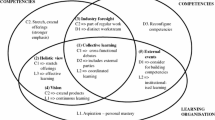Abstract
This book sets out to propose an integrated approach to risk management competency development to address the problem of talent shortage in this increasingly important bank function. We describe the overall research effort by presenting an overview of the preceding chapters as follows. Chapter 1 argues that staff recruitment and poaching alone would not suffice because we need to properly integrate new staff into the bank. Staff recruitment and poaching are mere short-term knee-jerk reactions which are not sustainable. Such actions increase compensation exponentially and do not really produce sufficient depth and breadth in the talent pool. Hence, banks need a more comprehensive way to develop their risk management competency. One way to do this is through the proposed integrated approach, which pools together three interrelated concepts of core competency, dynamic competency and the learning organization. We also translate the broad problem statement into three specific objectives, each of which is addressed in Chaps. 2, 3 and 4, respectively.
Chapter 2 seeks to address the first objective of operationalizing the concepts into indicators which pertain to the context of a bank’s risk management function. It begins by discussing the key foci of the three interrelated competency concepts. We show that the concepts are not identical because despite having some similarities, there are also subtle differences. Besides, the weaknesses in one concept are addressed by the strengths of at least one other concept. Hence, we propose the pooling together of these concepts to have a more comprehensive approach to competency development.
Chapter 2 also discusses how we translate these three concepts into operationalized indicators through a two-stage process. In the first stage, we review pertinent literature in the banking and risk management contexts. This facilitates the identification of indicators which illustrate the conceptual variables. In the second stage, we reaffirm our findings by interviewing ten leading chief risk officers. The interviews also reveal identification of additional indicators, all of which can be mapped to a conceptual variable. Hence, we compiled a list of 23 indicators which illustrate the conceptual variables for application in the context of a bank’s risk management function.
Next, Chap. 3 addresses the second objective which is to study whether the indicators differ across bank demographic groups. It begins by discussing how we use this questionnaire to survey 135 risk management professionals. The survey seeks to identify the extent to which each of the 23 indicators is practiced in the respondents’ banks. Before analyzing the survey findings, we perform diagnostic tests to ensure that the dataset is ready for use in the pertinent analytical techniques of t-test, discriminant analysis and factor analysis. Chapter 3 examines the indicators whose scores significantly differ between banks of different demographic groups, namely, local- versus foreign-controlled banks, entrepreneur- versus non-entrepreneur-controlled banks and across five differences.
The following Chap. 4 addresses the third and final objective, which is to study whether we can meaningfully summarize the indicators into a few themes. This was done through factor analysis which groups the like indicators into a factor or theme. We find that there is statistical support for this process and, more importantly, the indicators do meaningfully converge into the proposed theme labels.
Finally, this chapter discusses the findings obtained from the analyses as described in the preceding paragraphs. We organize the remainder of this chapter as follows. Section 5.1 recapitulates the aim of this book and the three specific objectives which emanate from this aim. Next, Sect. 5.2 discusses how the insights gained from the findings present conclusions relating to each of the three objectives and, hence, the aim of this book. Section 5.3 reflects on the limitations of this book which in turn sheds light on potential directions for future research and concludes.
Access this chapter
Tax calculation will be finalised at checkout
Purchases are for personal use only
Similar content being viewed by others
Author information
Authors and Affiliations
Corresponding author
Rights and permissions
Copyright information
© 2019 The Author(s)
About this chapter
Cite this chapter
Koh, E.H.Y. (2019). Conclusion: This Book’s Findings on Risk Management Competency Development. In: Risk Management Competency Development in Banks. Palgrave Macmillan Studies in Banking and Financial Institutions. Palgrave Pivot, Singapore. https://doi.org/10.1007/978-981-13-7599-6_5
Download citation
DOI: https://doi.org/10.1007/978-981-13-7599-6_5
Published:
Publisher Name: Palgrave Pivot, Singapore
Print ISBN: 978-981-13-7598-9
Online ISBN: 978-981-13-7599-6
eBook Packages: Economics and FinanceEconomics and Finance (R0)




